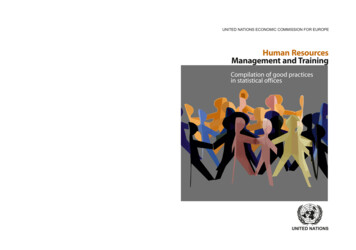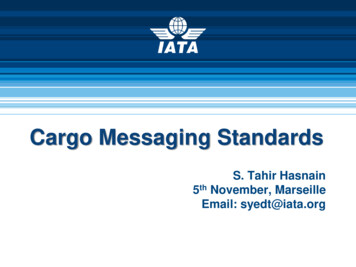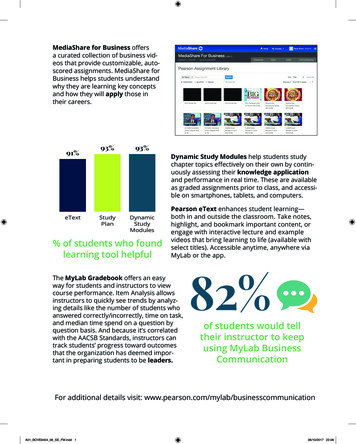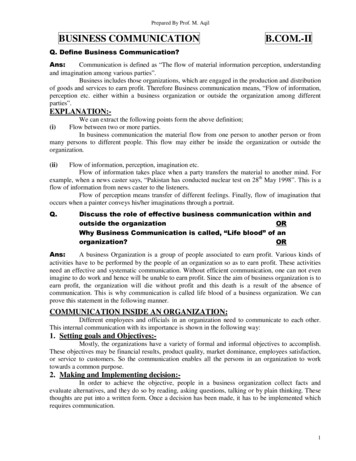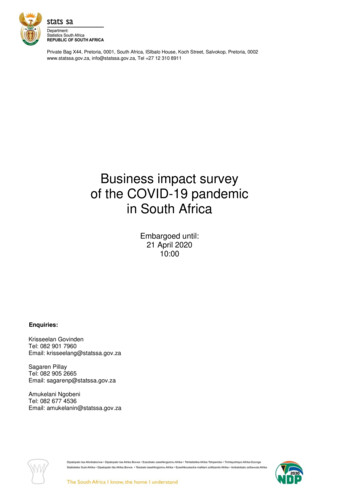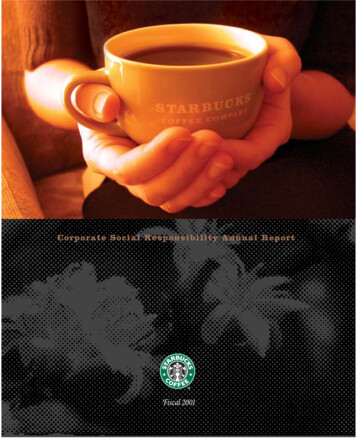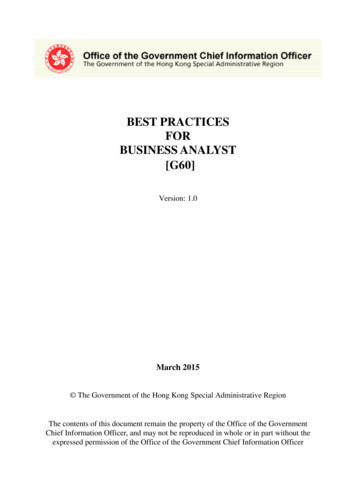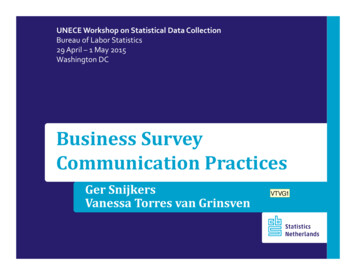
Transcription
UNECE Workshop on Statistical Data CollectionBureau of Labor Statistics29 April – 1 May 2015Washington DCBusiness SurveyCommunication PracticesGer SnijkersVanessa Torres van GrinsvenVTVG1
Slide 1VTVG1Of: Inquiry on business survey communication practicedOverview of resultsTorres van Grinsven, mevr. drs V., 23/04/2015
Overview Brief introduction:‐ What is Business Survey Communication?‐ It’s relevance? Overview of practices Thank you for sharing your practices! Thanks to Vanessa, who did most of the work;and to Taeke and Barteld for their assistance. Responses: 19 (response rate eligible units (30): 63%)We used: Introduction of the inquiry cover mail2 One reminder (which helped)
What worked for our inquiry Reminder Your interest in your topic Incentive: our promise of you getting feedback in theresults The inquiry has the characteristics of a business surveys Also regarding it’s communication3
Business Survey CommunicationAll communication with businesses selected for a survey, except for thecommunication within a questionnaire.Ultimate objective: To get response: timely, accurate and completeA Survey Communication Strategy is effective when this is achieved,within constraints!1. Internal process for designing and conducting the surveySampleMode of Data Coll.Guidelines &proceduresComm. strategyResponse: ‐ timelyBudget‐ complete‐ accurateQuestionnaire2. External processBusiness contextResponse burden3. Recurring surveysConsistency4
A Business Survey Communication Strategy is “A tailored and persuasive strategy that communicates:‐ the survey request,‐ related instructions and procedures, and‐ motivates and facilitates participants to comply with thesurvey request.To activate this role the survey communication strategy shouldbe an objective‐driven and coherent plan of communicationmeasures, activities and actions.”Holistic approach:This involves many communication materials and activities with alot of staff involved for various stages in the communicationprocess.It is the job of the survey communication designer to organizethis in such a way that the strategy is effective. This is a lot of work!5
The relevance of Survey CommunicationLet’s go back to 2012:1st UNECE Workshop in Statistical Data Collection:“New Frontiers on Statistical Data Collection”6
7
A shift in the balance of powerOne of you said:“The survey collects critically important data to informsound policy decisions. Response rates for these and othersurveys have been declining over the years for a number ofreasons.”One important reason mentioned is a change in the contextfor conducting the survey.So, we need to adapt and tailor our communication strategy.8
Survey Communication: part of survey designDesigning a business survey, includes: Planning the survey Sample design estimation Mode selection Questionnaire communication design Business Survey Communication Data collection Data capture, coding and cleaning Estimation Dissemination ArchivingAlso ‘survey communication’‐ often forgotten as a crucial element of the survey design!‐ often asked: “How do I get response?” “How do I do that?”The answer is Communication.9
InquiryResearch questions: Practices:What kind of communication practices are used as response enhancingtechniques at statistical agencies that conduct business surveys?‐ Ramirez & McCarthy (1998, 2007, 2012): Interagency Group ofEstablishment Nonresponse in the US Monitoring:Is the strategy monitored with regard to effectiveness (of achieving thegoals), costs, and effect on (perceived) response burden? Metrics:And, if so, what indicators/metrics are used? Design:How is the strategy designed? Is there a plan?10
Results of Inquiry: preliminaryGeneral conclusions: Long list of communication practices Shirt list of monitoring practices Diversity across agencies:‐ Practices vary from basics to an advancedcommunication strategy, including all kinds of means‐ In general not much monitoring is done, with exceptionof a small number of agencies Noting about costs!11
Overarching practices Websites/portals with‐‐‐‐information on the surveyFAQsSurvey calendarResults of previous survey Ombudsman/response advocate Branding of agency12
Pre‐field practices Pre‐notifications of survey to businesses Promotion of the survey, e.g. press releases Information campaigns in cooperation with industryassociations, local authorities Getting endorsement and support from industry associations Updating contact information Checking eligibility, profiling and identifying crucial units Feasability studies Pre‐testing of materials Planning key dates Training of staff13 Governance measures to reduce burden
Field practices Invitation / cover letter or email with more / lessinformation about the survey Flyers, folders, leaflets Professional and technical support:‐ Website, on‐line help‐ Helpdesk with support by phone Centralized collection portal Special attention to key businesses:‐ Courtesy calls Non‐response follow‐up:‐ Reminder letters,‐ Phone calls “Thank you” note14
Field practices (cont.) Large business managers Association endorsement letters and industry specific factsheets Send SMS/text message as reminder Reminder with interesting data Free consultations for respondents at regional offices Logging of all calls and contacts in a business providerinformation system15
Post‐field practices Enforcement: warning messages of financial penalties Recontacts for data validation of data, mostly by phone Feedback to respondents:‐ Customized output for respondents‐ Publication of collected data & notification of respondents‐ Benchmarking New Year greeting card with interesting statisticalinformation16
MonitoringResponse rates: unit levels and weighted ratesImputation ratesSurvey management systemActive collection management strategy using qualityindicators and impact scores, to prioritize units for non‐response follow‐up Applying PDCA‐cycle: discussing final metrics and planrefinements for future cycles Non‐response analysis 17
What worksEffecting survey participation and response behaviour in businesssurveys is very complex. Many factors affect this process, among them: Past response behaviour: investing in a relationship with businessesfrom the very first contact Incorrect information about units: updating contact information andeligibility Mandatory survey: but this also means that we should do our best tofacilitate businesses in accomplishing their task Trust in survey organisation: establishing trust by branding,endorsement, personalisation, confidentiality, non‐response follow‐up Relevance for businesses: What is in it for me? Relevance of surveytopic, providing relevant feedback Perceived workload (burden): pre‐notifications, mode ofdata collection18
ConclusionsSurvey communication is an essential part of the survey.To design an effective strategy we need: To know what we are doing:‐ Study response processes in businesses‐ Document and share current practices More experiments and effect studies before implementing(Boone/Walker presentation yesterday) Systematic monitoring: study the effectiveness and costs ofapplied strategiesIn order to improve: Apply PDCA‐cycle: Plan‐Do‐Evaluate‐Adjust19
Knowledge is money, also for retailers“Not just sit and wait, and see what happens. By monitoringyour processes you can see whether you’re on track, andwhether you need to make adjustments. Communicationwith your staff and clients is essential.”20
Thank you Questions? Question to you: Do you object to writing and publishing a paper onthis overview? If so, please, let me know.References Anseel, F., F. Lievens, E. Schollaert, and B. Choragwicka (2010), Response Ratesin Organizational Science, 1995–2008: A Meta‐Analytic Review and Guidelinesfor Survey Researchers. Journal of Business Psychology 25: 335–349. IGEN (Interagency Group on Establishment Nonresponse), 1998. Ramirez, C., and J. McCarthy, 2007/2012, IGEN presentation at ICES3/ICES4. Snijkers, G., G. Haraldsen, J. Jones, and D.K. Willimack (2013). Designing andConducting Business Surveys. Wiley, Hoboken. Snijkers, G., and J. Jones (2013), Business Survey Communication. Chapter 9 inSnijkers et al., Designing and Conducting Business Surveys. Wiley, Hoboken.21
Is there a plan? 10. Results of Inquiry: preliminary General conclusions: . New Year greeting card with interesting statistical information 16. Monitoring Response rates: unit levels and weighted rates Imputation rates Survey management system Active collection management strategy using quality indicators and impact scores, to prioritize units for non‐ response follow .
